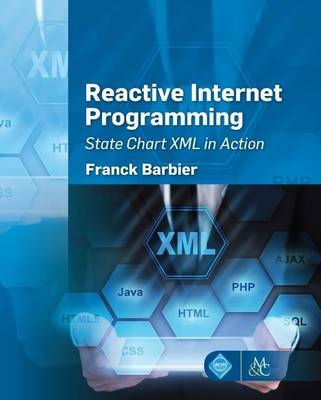
Reactive Internet Programming
Morgan & Claypool Publishers (Verlag)
978-1-970001-76-1 (ISBN)
Is Internet software so different from "ordinary" software? This book practically answers this question through the presentation of a software design method based on the State Chart XML W3C standard along with Java. Web enterprise, Internet-of-Things, and Android applications, in particular, are seamlessly specified and implemented from "executable models."
Internet software puts forward the idea of event-driven or reactive programming, as pointed out in Bonér et al.'s "Reactive Manifesto" (http://www.reactivemanifesto.org). It tells us that reactiveness is a must. However, beyond concepts, software engineers require effective means with which to put reactive programming into practice. This book's purpose is to outline and explain such means.
The lack of professional examples in the literature that illustrate how reactive software should be shaped can be quite frustrating. Therefore, this book helps to fill in that gap by providing in-depth professional case studies that contain comprehensive details and meaningful alternatives. Furthermore, these case studies can be downloaded for further investigation.
Internet software requires higher adaptation, at run time in particular. After reading Reactive Internet Programming, the reader therefore will be ready to enter the forthcoming Internet era.
Franck Barbier wrote his Computer Science (CS) thesis about the executability of object-oriented finite state machines at the University of Chambery (France) in 1991. He was an associate professor at the University of Nantes (France) from 1991-1999 and has been a full professor at the University of Pau (France) since 2000. Professor Barbier was the head of the CS research department of the University of Pau from 2000-2004 and deputy head of the Information and Communication Technologies department of the French Research Agency (ANR, ""The French NSF"") from 2009-2012.In the 1990s, Professor Barbier carried out three software realizations: PauWare (main author), BLU AGE (participation only), and Intelligent Software Factory (main author), sold by the Reich Technologies company. Over the last two decades, he has had approximately 50 large-scale responsibilities (training, consultancy, etc.) in international companies, including acting as a scientific consultant to Reich Technologies, one of the 17 companies that built UML 1.1 at the OMG in 1997. To that extent, he was also co-author of the documents submitted by the Australian DSTC consortium for the building of UML 2 in 2003, and from 2006-2015 he was a scientific consultant at Netfective Technology, the editor of the BLU AGE modeldriven development tool suite. Professor Barbier has supervised 15 computer science theses in France, Spain, and Sweden; published 6 books (as editor or author); and written approximately 140 articles in refereed journals, books, conference proceedings, and professional magazines, including e-magazines. His research activities and interests include object/component/service modeling through UML and the State Chart XML W3 standard, model-driven development, software design, test and runtime management for mobile and Internet software, software adaptation, executable models, and models at runtime.
1. Introduction
2. Event and State-based Modeling and Programming
3. Applying State Chart XML
4. Programming State Chart XML Models
5. Execution Semantics
6. Advanced Programming with PauWare engine
7. Programming the ""Internet of Things""
8. Programming Web Enterprise Component Management
9. Software Component Management
Appendix A. Internal Structure of PauWare Engine
Appendix B. Acronyms
Appendix C. Software
References
Author's Biography
| Erscheinungsdatum | 05.05.2016 |
|---|---|
| Verlagsort | San Rafael |
| Sprache | englisch |
| Maße | 191 x 235 mm |
| Gewicht | 460 g |
| Themenwelt | Informatik ► Programmiersprachen / -werkzeuge ► XML |
| Mathematik / Informatik ► Informatik ► Software Entwicklung | |
| Mathematik / Informatik ► Informatik ► Web / Internet | |
| ISBN-10 | 1-970001-76-3 / 1970001763 |
| ISBN-13 | 978-1-970001-76-1 / 9781970001761 |
| Zustand | Neuware |
| Haben Sie eine Frage zum Produkt? |
aus dem Bereich
